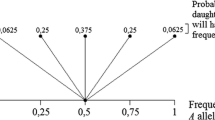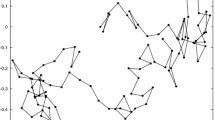Abstract
The Hardy–Weinberg equilibrium has been argued by Sober, Stephens and others to represent the zero-force state for evolutionary biology understood as a theory of forces. I investigate what it means for a model to involve forces, developing an explicit account by defining what the zero-force state is in a general theoretical context. I use this account to show that Hardy–Weinberg equilibrium is not the zero-force state in biology even in the contexts in which it applies, and argue based on this that drift should not be understood as an evolutionary force.
Similar content being viewed by others
Notes
This simplifies Aristotelian physics. Actual Aristotelian mechanics doesn’t have a fully coherent treatment of rates of change. Our discussion of Aristotelian mechanics here will therefore be a somewhat idealized and anachronistic one, as suits our need to draw a particular conceptual contrast with Newtonian mechanics. The issue is that a fully coherent ‘Aristotelian’ view such as is presented here conflicts too obviously with empirical evidence. In particular, how velocity changes after a force is removed is a problem that historically meets various attempted solutions, which make the mechanics more empirically adequate but less conceptually pure; this account ignores these solutions. The difficulty can be understood as a tension between the idea that velocity must proportional to the force applied and should be zero in the absence of a force (which is key to our treatment of Aristotelianism), with the observation that a thrown object loses its velocity gradually, even though the force would appear to cease once the thrown object leaves the hand.
As well as the resistance to that force: in Aristotelian mechanics, the resistance of the medium is always factored into the velocity.
To be more precise, we might say that the magnitude of the force is the absolute value of the variable, since whether the variable is positive or negative just tells us the direction in which the force acts.
The difference is just that parameters aren’t subject to experimental manipulations—e.g. the gravitational constant.
References
Gillespie JH (2001) Is the population size of a species relevant to its evolution? Evolution 55:2161–2169
Heisler IL, Damuth J (1987) A method for analyzing selection in hierarchically structured populations. Am Nat 130:582–602
Hitchcock C, Velasco JD (2014) Evolutionary and newtonian forces. Ergo 1:39–77
Lewens T (2010) The natures of selection. Br J Philos Sci 61:313–333
Matthen M, Ariew A (2002) Two ways of thinking about fitness and natural selection. J Philos 44:55–84
Matthen M, Ariew A (2005) How to understand causal relations in natural selection: reply to Rosenberg and Bouchard. Biol Philos 20:355–364
Matthen M, Ariew A (2009) Selection and causation. Philos Sci 76:201–224
McShea DW, Brandon RN (2010) Biology’s first law: the tendency for diversity and complexity to increase in evolutionary systems. University of Chicago Press, Chicago
Millstein RL (2002) Are random drift and natural selection conceptually distinct? Biol Philos 17:33–53
Reisman K, Forber P (2005) Manipulation and the causes of evolution. Philos Sci 72:1113–1123
Sober E (1984) The nature of selection. The MIT Press, Cambridge
Sober E, Shapiro L (2007) Epiphenomenalism: The do’s and the don’ts. In: Wolters G, Machamer PK (eds) Studies in causality: historical and contemporary. University of Pittsburgh Press, Pittsburgh
Stephens C (2004) Selection, drift, and the “Forces” of evolution. Philos Sci 71:550–570
Stephens C (2010) Forces and causes in evolutionary theory. Philos Sci 77:716–727
Walsh DM (2004) Bookkeeping or metaphysics? The units of selection debate. Synthese 138:337–361
Walsh DM (2007) The pomp of superfluous causes: the interpretation of evolutionary theory. Philos Sci 74:281–303
Walsh DM (2013) Descriptions and models: some responses to abrams. Stud Hist Philos Sci Part C Stud Hist Philos Biol Biomed Sci 44:302–308
Walsh DM, Lewens T, Ariew A (2002) The trials of life: natural selection and random drift. Philos Sci 69:452–473
Woodward J (2003) Making things happen. Oxford University Press, London
Acknowledgments
I would like to thank Denis Walsh, Samir Okasha, Jacob Stegenga, Philippe Huneman, Cory Lewis, Alex Djedovic, Fermin Fulda, Michael Cournoyea, Christopher Stephens and an anonymous reviewer for their helpful comments and encouragement.
Author information
Authors and Affiliations
Corresponding author
Rights and permissions
About this article
Cite this article
Earnshaw, E. Evolutionary forces and the Hardy–Weinberg equilibrium. Biol Philos 30, 423–437 (2015). https://doi.org/10.1007/s10539-014-9464-9
Received:
Accepted:
Published:
Issue Date:
DOI: https://doi.org/10.1007/s10539-014-9464-9




